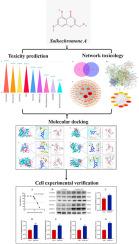Network toxicology and cell experiments reveal the mechanism of saikochromone A-induced hepatotoxicity
IF 2.4
4区 医学
Q2 PHARMACOLOGY & PHARMACY
引用次数: 0
Abstract
The potential toxicity of traditional Chinese medicine (TCM) remains a significant barrier to its broader clinical application. Bupleurum, a commonly used TCM, contains saponins and volatile oils that have been shown to cause hepatotoxicity. Due to the complex chemical composition of Bupleurum, saikochromone A (SA), another major bioactive component, has not been thoroughly assessed in terms of its toxicological profile and underlying mechanisms. Our study aimed to evaluate the potential hepatotoxic effects of SA by integrating network toxicology, molecular docking analysis, and in vitro experimental approaches. A total of 109 possible targets associated with SA-induced hepatotoxicity were identified through the publicly available online databases. Functional enrichment analysis revealed significant involvement of pathways related to chemical carcinogenesis (DNA adducts) and cytochrome P450-mediated metabolism. Molecular docking simulations further demonstrated strong binding affinities between SA and key proteins, including CYP2E1, CYP1A1, CYP3A4, PTGS2, and MMP-9. In vitro experiments showed that SA significantly reduced cell viability, with an IC50 value of 176.8 μM. Additionally, SA exposure was found to upregulate the expression levels of CYP2E1, CYP1A1, CYP3A4, PTGS2, and MMP-9. By combining computational and experimental methodologies, this study systematically elucidates, for the first time, that high concentrations of SA may induce hepatotoxicity primarily through the CYP450 enzyme system, inflammatory pathway, and matrix metalloproteinase activation. These findings offer a novel methodological framework for identifying and evaluating toxic components in TCM and contribute valuable insights into the potential adverse effects of TCM in clinical practice.

网络毒理学和细胞实验揭示了Saikochromone a诱导肝毒性的机制。
中药的潜在毒性仍然是其广泛临床应用的一个重要障碍。柴胡是一种常用的中药,含有皂苷和挥发油,已被证明会导致肝毒性。由于柴胡的化学成分复杂,柴胡另一主要生物活性成分柴胡色素A (saikochromone A, SA)的毒理学特征和作用机制尚未得到充分的研究。我们的研究旨在通过网络毒理学、分子对接分析和体外实验方法来评估SA的潜在肝毒性作用。通过公开的在线数据库,共确定了109个与sa诱导的肝毒性相关的可能靶点。功能富集分析显示,与化学致癌(DNA加合物)和细胞色素p450介导的代谢相关的途径显著参与。分子对接模拟进一步证明了SA与CYP2E1、CYP1A1、CYP3A4、PTGS2和MMP-9等关键蛋白之间具有很强的结合亲和力。体外实验表明,SA可显著降低细胞活力,IC50值为176.8 μM。此外,SA暴露被发现上调CYP2E1、CYP1A1、CYP3A4、PTGS2和MMP-9的表达水平。通过计算和实验相结合的方法,本研究首次系统地阐明了高浓度SA可能主要通过CYP450酶系统、炎症途径和基质金属蛋白酶激活诱导肝毒性。这些发现为识别和评估中药有毒成分提供了一个新的方法学框架,并为中医在临床实践中的潜在不良反应提供了有价值的见解。
本文章由计算机程序翻译,如有差异,请以英文原文为准。
求助全文
约1分钟内获得全文
求助全文
来源期刊

Toxicon
医学-毒理学
CiteScore
4.80
自引率
10.70%
发文量
358
审稿时长
68 days
期刊介绍:
Toxicon has an open access mirror Toxicon: X, sharing the same aims and scope, editorial team, submission system and rigorous peer review. An introductory offer Toxicon: X - full waiver of the Open Access fee.
Toxicon''s "aims and scope" are to publish:
-articles containing the results of original research on problems related to toxins derived from animals, plants and microorganisms
-papers on novel findings related to the chemical, pharmacological, toxicological, and immunological properties of natural toxins
-molecular biological studies of toxins and other genes from poisonous and venomous organisms that advance understanding of the role or function of toxins
-clinical observations on poisoning and envenoming where a new therapeutic principle has been proposed or a decidedly superior clinical result has been obtained.
-material on the use of toxins as tools in studying biological processes and material on subjects related to venom and antivenom problems.
-articles on the translational application of toxins, for example as drugs and insecticides
-epidemiological studies on envenoming or poisoning, so long as they highlight a previously unrecognised medical problem or provide insight into the prevention or medical treatment of envenoming or poisoning. Retrospective surveys of hospital records, especially those lacking species identification, will not be considered for publication. Properly designed prospective community-based surveys are strongly encouraged.
-articles describing well-known activities of venoms, such as antibacterial, anticancer, and analgesic activities of arachnid venoms, without any attempt to define the mechanism of action or purify the active component, will not be considered for publication in Toxicon.
-review articles on problems related to toxinology.
To encourage the exchange of ideas, sections of the journal may be devoted to Short Communications, Letters to the Editor and activities of the affiliated societies.
 求助内容:
求助内容: 应助结果提醒方式:
应助结果提醒方式:


